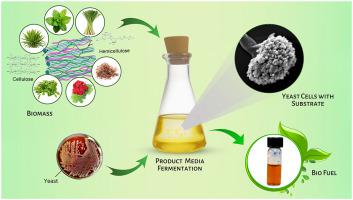当前位置:
X-MOL 学术
›
Biomass Bioenergy
›
论文详情
Our official English website, www.x-mol.net, welcomes your feedback! (Note: you will need to create a separate account there.)
Production of fatty acids from distilled aromatic waste biomass using oleaginous yeast
Biomass & Bioenergy ( IF 5.8 ) Pub Date : 2024-04-23 , DOI: 10.1016/j.biombioe.2024.107213 Suman Singh , Shivani Chaturvedi , Naziya Syed , Dheerendra Rastogi , Prashant Kumar , Praveen Kumar Sharma , Deepak Kumar , Debesmita Sahoo , Nitin Srivastava , Ashween Deepak Nannaware , Sunil Kumar Khare , Prasant Kumar Rout
Biomass & Bioenergy ( IF 5.8 ) Pub Date : 2024-04-23 , DOI: 10.1016/j.biombioe.2024.107213 Suman Singh , Shivani Chaturvedi , Naziya Syed , Dheerendra Rastogi , Prashant Kumar , Praveen Kumar Sharma , Deepak Kumar , Debesmita Sahoo , Nitin Srivastava , Ashween Deepak Nannaware , Sunil Kumar Khare , Prasant Kumar Rout

|
Microbial lipids are feasible alternatives to vegetable oils and fats in the production of biodiesel and other industrially significant compounds. To achieve the main goals of the circular economy, waste materials go under microbiological processes, it reduces wastes through recycling. To show the effectiveness of the suggested strategy, four fungi, and four oleaginous yeasts were used in the present investigation. Along with this, distilled biomasses from different aromatic crops (lemongrass, mentha, citronella, geranium, ocimum, palmarosa) were used for microbial growth and lipid production. The distillation process acts as a pretreatment step for the fermentation of lignocellulosic biomass. The heat results in the breakdown of some bonds to easily release monomers and increase the available surface for the action of hydrolytic enzymes produced by fermenting microbes to release monomers which may be used further for lipid production. The lipid content obtained by and under optimized growth conditions were found significant in comparison to other strains, control 1 and 2. Lemongrass, citronella, ocimum, and palmarosa showed a promising lipid accumulation in comparison to other distilled biomasses. The major fatty acids produced by were oleic, linoleic, linolenic and lignoceric acid from after distilled biomass of mentha, citronella and ocimum. Principal component analysis was performed to observe the variability within the dataset and provide evidence that the results are matching with the observations. Scanning electron microscopy and confocal fluorescence microscopy were also performed to confirm the lipid production by and . The oil obtained from was further transesterified and assessed for their physical properties as biodiesel. It is found suitable to be used as bio-based fuel with the EN 14214 as well as ASTM standards. As a result, the distilled biomasses will provide a low-cost alternative for yeast growth that leads to accumulation of lipids and subsequently biodiesel generation. In order to integrate biotechnological processes in a circular economy challenge, this study offers convincing evidence that the valorization of distilled biomasses to lipid production using oleaginous yeasts is promising.
中文翻译:

使用含油酵母从蒸馏芳香废物生物质生产脂肪酸
在生物柴油和其他工业上重要的化合物的生产中,微生物脂质是植物油和脂肪的可行替代品。为了实现循环经济的主要目标,废物经过微生物处理,通过回收减少废物。为了显示所建议策略的有效性,本研究中使用了四种真菌和四种产油酵母。与此同时,来自不同芳香作物(柠檬草、薄荷、香茅、天竺葵、罗勒、玫瑰草)的蒸馏生物质被用于微生物生长和脂质生产。蒸馏过程充当木质纤维素生物质发酵的预处理步骤。热量导致一些键断裂,从而容易释放单体,并增加发酵微生物产生的水解酶作用的可用表面,以释放可进一步用于脂质生产的单体。与其他菌株(对照 1 和 2)相比,优化生长条件下获得的脂质含量显着。与其他蒸馏生物质相比,柠檬草、香茅、罗勒和玫瑰草显示出有希望的脂质积累。从薄荷、香茅和罗勒的生物质蒸馏后产生的主要脂肪酸是油酸、亚油酸、亚麻酸和木蜡酸。进行主成分分析是为了观察数据集中的变异性,并提供结果与观察结果相匹配的证据。还进行了扫描电子显微镜和共焦荧光显微镜以确认 和 的脂质产生。从中获得的油进一步进行酯交换并评估其作为生物柴油的物理特性。 它被发现适合用作符合 EN 14214 和 ASTM 标准的生物基燃料。因此,蒸馏后的生物质将为酵母生长提供低成本替代方案,从而导致脂质积累并随后产生生物柴油。为了将生物技术过程整合到循环经济挑战中,这项研究提供了令人信服的证据,表明使用产油酵母将蒸馏生物质用于脂质生产的价值是有希望的。
更新日期:2024-04-23
中文翻译:

使用含油酵母从蒸馏芳香废物生物质生产脂肪酸
在生物柴油和其他工业上重要的化合物的生产中,微生物脂质是植物油和脂肪的可行替代品。为了实现循环经济的主要目标,废物经过微生物处理,通过回收减少废物。为了显示所建议策略的有效性,本研究中使用了四种真菌和四种产油酵母。与此同时,来自不同芳香作物(柠檬草、薄荷、香茅、天竺葵、罗勒、玫瑰草)的蒸馏生物质被用于微生物生长和脂质生产。蒸馏过程充当木质纤维素生物质发酵的预处理步骤。热量导致一些键断裂,从而容易释放单体,并增加发酵微生物产生的水解酶作用的可用表面,以释放可进一步用于脂质生产的单体。与其他菌株(对照 1 和 2)相比,优化生长条件下获得的脂质含量显着。与其他蒸馏生物质相比,柠檬草、香茅、罗勒和玫瑰草显示出有希望的脂质积累。从薄荷、香茅和罗勒的生物质蒸馏后产生的主要脂肪酸是油酸、亚油酸、亚麻酸和木蜡酸。进行主成分分析是为了观察数据集中的变异性,并提供结果与观察结果相匹配的证据。还进行了扫描电子显微镜和共焦荧光显微镜以确认 和 的脂质产生。从中获得的油进一步进行酯交换并评估其作为生物柴油的物理特性。 它被发现适合用作符合 EN 14214 和 ASTM 标准的生物基燃料。因此,蒸馏后的生物质将为酵母生长提供低成本替代方案,从而导致脂质积累并随后产生生物柴油。为了将生物技术过程整合到循环经济挑战中,这项研究提供了令人信服的证据,表明使用产油酵母将蒸馏生物质用于脂质生产的价值是有希望的。
















































 京公网安备 11010802027423号
京公网安备 11010802027423号